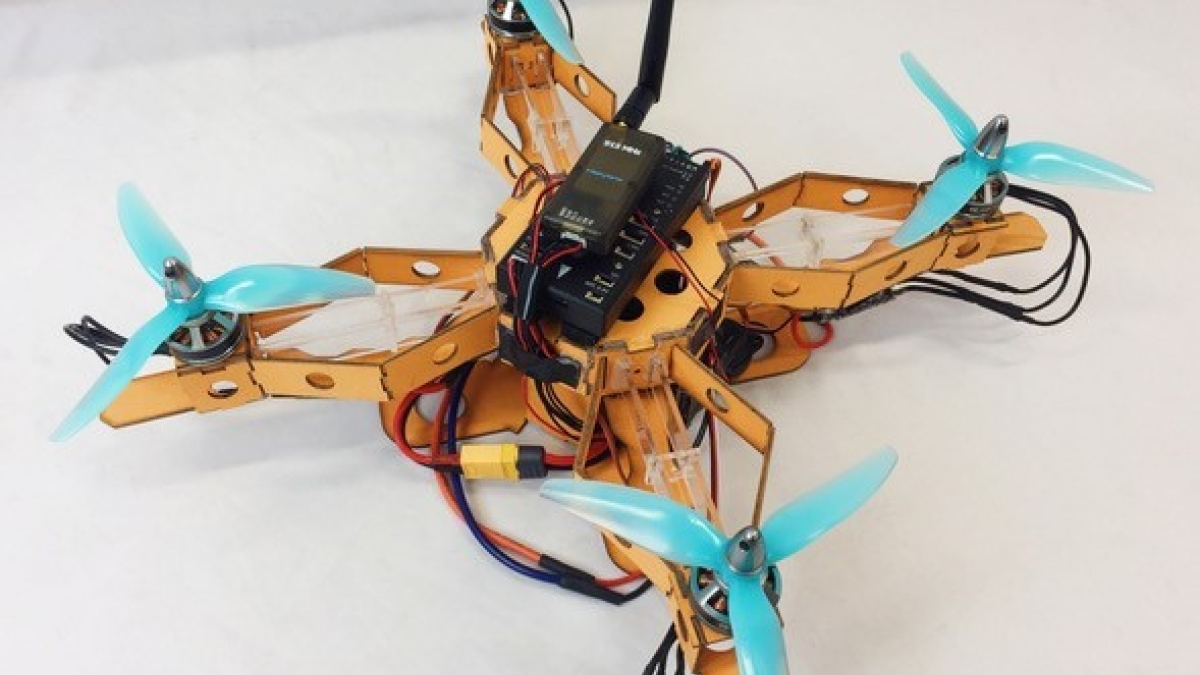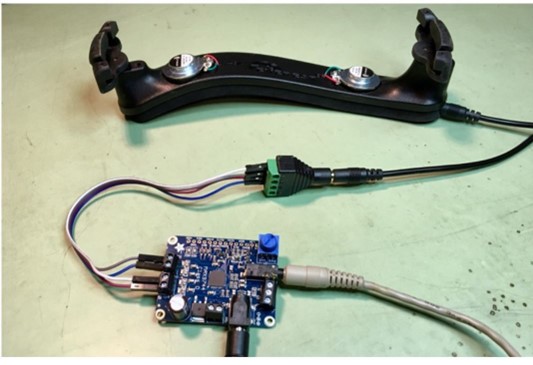ASU ranks in top 10 among US universities granted US utility patents in 2022

ASU-based technologies that received patents in 2022 include foldable quadrotors (prototype shown). Photo courtesy School of Manufacturing Systems and Networks/ASU
Editor’s note: This story is featured in the 2023 year in review.
Arizona State University remains in the top 10 among universities nationwide for U.S. utility patents issued in 2022, increasing its patents over the previous year.
This marks the fifth consecutive time ASU ranked in the top 10 among U.S.-based universities in the annual top 100 rankings by the National Academy of Inventors and the Intellectual Property Owners Association. ASU ranked No. 11 among universities worldwide.
The report uses calendar-year data from the U.S. Patent and Trademark Office to find patents that list universities. This year’s report counts patents with universities listed as an owner regardless of the order in which owners are listed on the patent to provide a more comprehensive look at patents held by universities. Previously, the National Academy of Inventors included only the first-named owner in the count.
ASU secured 160 U.S. patents in 2022, joining other universities in the top 10, including, MIT, Stanford University, University of Texas, Purdue University, Caltech and Harvard University. The 160 U.S. patents are an increase from 153 in the prior year.
“This well-earned distinction once again speaks to the ingenuity of our faculty members and their commitment to discovery,” said Sally C. Morton, executive vice president of ASU’s Knowledge Enterprise. “There is a bounty of brilliant and novel ideas pioneered by our researchers, and an increasing number of them are making their way to market with meaningful impact for the public. It’s our responsibility to continually advance such ideas and transform them into solutions that benefit the world.”
ASU-based technologies that received patents in 2022 include foldable quadrotors, a violin shoulder rest with haptic feedback, prosthetic limbs, a power-generating brick, and recovery and recycling systems to remove platinum-group metals from wastewater.
Skysong Innovations, ASU’s exclusive technology transfer and intellectual property management organization, helps translate research into impact by protecting intellectual property developed in ASU labs and negotiating licensing deals with commercial partners who advance the patented technologies and develop solutions for society.
The organization has secured nearly 1,450 U.S. patents and closed nearly 1,400 option or license deals with commercial partners during its years of service to ASU. Skysong Innovations has facilitated more than 200 ASU startups that have collectively attracted more than $1.2 billion in external funding and generated more than $2 billion in economic impact in Arizona.
“ASU’s slate of patented technologies in 2022 spans cutting-edge fields from artificial intelligence to precision cancer therapies,” said Kyle Siegal, senior vice president and chief patent counsel of Skysong Innovations. “This variety underscores the impressive breadth with which ASU advances real-world solutions for the public good.”
The report, released today in conjunction with World Intellectual Property (IP) Day, is intended to showcase the importance of patents in university research and innovation.
"As we celebrate World IP Day, I am so pleased to see this evidence of the international impact of research and innovation conducted at academic institutions around the globe,” said Kathi Vidal, under secretary of commerce for intellectual property and director of the United States Patent and Trademark Office.
ASU has been ranked No. 1 in innovation by U.S. News and World Report for all eight years the category has existed.
“Arizona State University’s consistent achievement as a top recipient of U.S. utility patents reflects the strength and creativity of our culture of innovation,” ASU President Michael M. Crow said. “We are designed to inspire, connect and support next-level problem solvers as they advance big ideas and outcomes, and we intentionally assess how our efforts can help to elevate humanity.”
Below is a look at some of the ASU technologies that received patents in 2022.
Foldable quadrotors
ASU researchers invented an origami-inspired, foldable quadrotor that can improve maneuverability among unmanned aerial vehicles.
This patented design enables the quadrotor to morph its external shape in flight for changing environments.
The researchers invented an advanced multilayer manufacturing process that uses laser-cut cardboard to reduce costs and fabrication time.
Inventors include Associate Professor Wenlong Zhang and Assistant Professor Daniel Aukes, both of the School of Manufacturing Systems and Networks in the Ira A. Fulton Schools of Engineering, Shatadal Mishra, graduate research associate, and Dangli Yang, graduate student.
Power-generating bricks
Some day you may be able to charge your smart phone directly from a building’s brick walls.
Researchers from ASU, King’s College London and University of New South Wales (UNSW) Sydney invented a power-generating thermogalvanic brick, which converts the difference between a building’s interior and exterior temperature into direct electrical power both during the day and night.
The three research universities collaborate through the PLuS Alliance to solve global challenges.
Buildings account for about 40% of all energy consumed, and there is growing demand from new embedded electronic devices, which requires consideration for the environment.
Much of the design can be 3D printed using recycled plastics.
The patented technology could be used for off-grid and remote buildings, as well as warehouses and “smart structures.”
Patrick Phelan, professor in the ASU School for Engineering of Matter, Transport and Energy, was one of the inventors, along with ASU graduate assistant Benjamin Obeng, Leigh Aldous from King’s College and Robert Taylor from UNSW Sydney.
Shoulder rest with haptic feedback
A violin shoulder rest with haptic feedback to enable the musician’s body to feel vibrations that can be used for performance coordinating, cuing and conducting. Photo courtesy Seth Thorn/ASU
Violinist Seth Thorn, a clinical assistant professor in the School of Arts, Media and Engineering, has spent years exploring how to enhance the musician’s experience.
He invented a violin shoulder rest that actuates the violin through vibration, which can transform the sound of the instrument and provide haptic feedback for coordinating, cuing and conducting.
“I’m thrilled to see the way students react to the shoulder rest when they put it on the violin. I get these astonished reactions, because it transforms the way the violin sounds and feels,” Thorn said. “Since it replaces an accessory already in wide use, you wouldn’t notice a difference if it weren’t plugged in, and that’s part of the magic.”
Thorn is part of a collaborative study with faculty across ASU that brings his invention into various string projects in the Phoenix community, including Rosie’s House, which offers free music lessons to underserved youth. The study is supported by a grant from the Herberger Institute for Design and the Arts.
Thorn’s startup Matter Squared signed an option to license the patented ASU technology and plans to scale up manufacturing so more young musicians can experience a new way to create and learn to play music.
Prosthetic limbs
Artificial limbs, or prosthetics, are meant to restore some normal function for people with amputations or congenital limb defects. They are custom made, which leads to higher manufacturing time and production costs.
Below-the-knee prosthetics can be uncomfortable and cause upper leg pain because they lack proper gait impact absorption.
ASU researchers conquered many of the limitations of conventional devices by designing comfortable, custom prosthetics that are quick to produce, cost effective, strong and highly functional.
Jeff La Belle, former ASU biomedical engineering professor in the School of Biological and Health Systems Engineering, and Courtney Mason, graduate student, were the inventors.
Precious metal recovery from wastewater
ASU researchers developed a system to remove and recover platinum-group metals such as palladium from wastewaters associated with mining, metal-refining and catalytic-converter industries.
Conventional methods to recovering the precious metals from wastewaters are limited by labor, capital, operating expenses and the environmental release of toxic agents.
Precient Technologies licenses the patented system that removes contaminants from waste streams and recovers and recycles the precious metals that are already in limited supply.
Inventors of the precious metal recovery and recycle system include Bruce Rittmann, center director and professor in the Biodesign Swette Center for Environmental Biotechnology; Chen Zhou, research assistant professor in the Swette Center; Andrew Marcus, former assistant research professor in the Swette Center; Aura Ontiveros-Valencia, postdoctoral research associate; Rosa Krajmalnik-Brown, center director and professor in the Biodesign Center for Health Through Microbiomes; and Zhaocheng Wang, graduate research associate in the School of Sustainable Energy and Built Environment.
Note: This story was updated to reflect new rankings that were issued on May 25. NAI indicated in its update that the list is a dynamic list.
More Science and technology

Applied Materials invests in ASU to advance technology for a brighter future
For nearly 60 years, global giant Applied Materials has been hard at work engineering technology that continues to change how…

Meet ASU engineering students who are improving health care, computing and more
Furthering knowledge of water resource management, increasing the efficiency of manufacturing point-of-care health diagnostic…

Turning up the light: Plants, semiconductors and fuel production
What can plants and semiconductors teach us about fuel production?ASU's Gary Moore hopes to find out.With the aim of learning how…


